标签:结构 confirm 文件中 inf 发送消息 uri yml rate 生成
本项目使用MQ实现页面发布的技术方案如下:

技术方案说明:
1、平台包括多个站点,页面归属不同的站点。
2、发布一个页面应将该页面发布到所属站点的服务器上。
3、每个站点服务部署cms client程序,并与交换机绑定,绑定时指定站点Id为routingKey。
指定站点id为routingKey就可以实现cms client只能接收到所属站点的页面发布消息。
4、页面发布程序向MQ发布消息时指定页面所属站点Id为routingKey,将该页面发布到它所在服务器上的cms
client。
页面发布流程图如下:
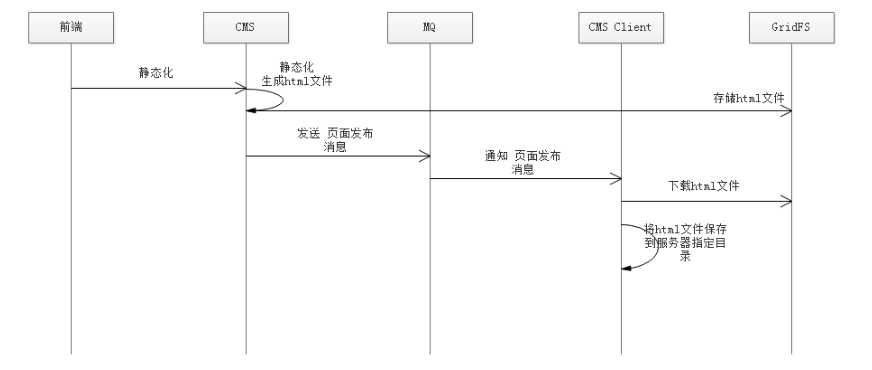
1、前端请求cms执行页面发布。
2、cms执行静态化程序生成html文件。
3、cms将html文件存储到GridFS中。
4、cms向MQ发送页面发布消息
5、MQ将页面发布消息通知给Cms Client
6、Cms Client从GridFS中下载html文件
7、Cms Client将html保存到所在服务器指定目录
功能分析:
创建Cms Client工程作为页面发布消费方,将Cms Client部署在多个服务器上,它负责接收到页面发布 的消息后从
GridFS中下载文件在本地保存。
需求如下:
1、将cms Client部署在服务器,配置队列名称和站点ID。
2、cms Client连接RabbitMQ并监听各自的“页面发布队列”
3、cms Client接收页面发布队列的消息
4、根据消息中的页面id从mongodb数据库下载页面到本地
调用 dao查询页面信息,获取到页面的物理路径,调用dao查询站点信息,得到站点的物理路径
页面物理路径=站点物理路径+页面物理路径+页面名称。
从GridFS查询静态文件内容,将静态文件内容保存到页面物理路径下。
pom.xml依赖

<?xml version="1.0" encoding="UTF‐8"?> <project xmlns="http://maven.apache.org/POM/4.0.0" xmlns:xsi="http://www.w3.org/2001/XMLSchema‐instance" xsi:schemaLocation="http://maven.apache.org/POM/4.0.0 http://maven.apache.org/xsd/maven‐4.0.0.xsd"> <parent> <artifactId>xc‐framework‐parent</artifactId> <groupId>com.xuecheng</groupId> <version>1.0‐SNAPSHOT</version> <relativePath>../xc‐framework‐parent/pom.xml</relativePath> </parent> <modelVersion>4.0.0</modelVersion> <artifactId>xc‐service‐manage‐cms‐client</artifactId> <dependencies> <dependency> <groupId>com.xuecheng</groupId> <artifactId>xc‐framework‐model</artifactId> <version>1.0‐SNAPSHOT</version> </dependency> <dependency> <groupId>org.springframework.boot</groupId> <artifactId>spring‐boot‐starter‐test</artifactId> <scope>test</scope> </dependency> <dependency> <groupId>org.springframework.boot</groupId> <artifactId>spring‐boot‐starter‐amqp</artifactId> </dependency> <dependency> <groupId>org.springframework.boot</groupId> <artifactId>spring‐boot‐starter‐data‐mongodb</artifactId> </dependency> <dependency> <groupId>org.apache.commons</groupId> <artifactId>commons‐io</artifactId> </dependency> <dependency> <groupId>com.alibaba</groupId> <artifactId>fastjson</artifactId> </dependency> </dependencies> </project>
在resources下配置application.yml和logback-spring.xml。
application.yml的内容如下:
server: port: 31000 spring: application: name: xc‐service‐manage‐cms‐client data: mongodb: uri: mongodb://root:123@localhost:27017 database: xc_cms rabbitmq: host: 127.0.0.1 port: 5672 username: guest password: guest virtualHost: / xuecheng: mq: #cms客户端监控的队列名称(不同的客户端监控的队列不能重复) queue: queue_cms_postpage_01 routingKey: 5a751fab6abb5044e0d19ea1 #此routingKey为门户站点ID
说明:在配置文件中配置队列的名称,每个 cms client在部署时注意队列名称不要重复
@SpringBootApplication @EntityScan("com.xuecheng.framework.domain.cms")//扫描实体类 @ComponentScan(basePackages={"com.xuecheng.framework"})//扫描common下的所有类 @ComponentScan(basePackages={"com.xuecheng.manage_cms_client"}) public class ManageCmsClientApplication { public static void main(String[] args) { SpringApplication.run(ManageCmsClientApplication.class, args); } }
消息队列设置如下:
1、创建“ex_cms_postpage”交换机
2、每个Cms Client创建一个队列与交换机绑定
3、每个Cms Client程序配置队列名称和routingKey,将站点ID作为routingKey。

package com.xuecheng.manage_cms_client.config; import org.springframework.amqp.core.*; import org.springframework.beans.factory.annotation.Qualifier; import org.springframework.beans.factory.annotation.Value; import org.springframework.context.annotation.Bean; import org.springframework.context.annotation.Configuration; /** * @author Administrator * @version 1.0 **/ @Configuration public class RabbitmqConfig { //队列bean的名称 public static final String QUEUE_CMS_POSTPAGE = "queue_cms_postpage"; //交换机的名称 public static final String EX_ROUTING_CMS_POSTPAGE="ex_routing_cms_postpage"; //队列的名称 @Value("${xuecheng.mq.queue}") public String queue_cms_postpage_name; //routingKey 即站点Id @Value("${xuecheng.mq.routingKey}") public String routingKey; /** * 交换机配置使用direct类型 * @return the exchange */ @Bean(EX_ROUTING_CMS_POSTPAGE) public Exchange EXCHANGE_TOPICS_INFORM() { return ExchangeBuilder.directExchange(EX_ROUTING_CMS_POSTPAGE).durable(true).build(); } //声明队列 @Bean(QUEUE_CMS_POSTPAGE) public Queue QUEUE_CMS_POSTPAGE() { Queue queue = new Queue(queue_cms_postpage_name); return queue; } /** * 绑定队列到交换机 * * @param queue the queue * @param exchange the exchange * @return the binding */ @Bean public Binding BINDING_QUEUE_INFORM_SMS(@Qualifier(QUEUE_CMS_POSTPAGE) Queue queue, @Qualifier(EX_ROUTING_CMS_POSTPAGE) Exchange exchange) { return BindingBuilder.bind(queue).to(exchange).with(routingKey).noargs(); } }
消息内容采用json格式存储数据,如下:
页面id:发布页面的id
{ "pageId":"" }
1、使用CmsPageRepository 查询页面信息
public interface CmsPageRepository extends MongoRepository<CmsPage,String> { }
2、使用CmsSiteRepository查询站点信息,主要获取站点物理路径
public interface CmsSiteRepository extends MongoRepository<CmsSite,String> { }
在Service中定义保存页面静态文件到服务器物理路径方法:

package com.xuecheng.manage_cms_client.service; import com.mongodb.client.gridfs.GridFSBucket; import com.mongodb.client.gridfs.GridFSDownloadStream; import com.mongodb.client.gridfs.model.GridFSFile; import com.xuecheng.framework.domain.cms.CmsPage; import com.xuecheng.framework.domain.cms.CmsSite; import com.xuecheng.framework.domain.cms.response.CmsCode; import com.xuecheng.framework.exception.ExceptionCast; import com.xuecheng.manage_cms_client.dao.CmsPageRepository; import com.xuecheng.manage_cms_client.dao.CmsSiteRepository; import org.apache.commons.io.IOUtils; import org.springframework.beans.factory.annotation.Autowired; import org.springframework.data.mongodb.core.query.Criteria; import org.springframework.data.mongodb.core.query.Query; import org.springframework.data.mongodb.gridfs.GridFsResource; import org.springframework.data.mongodb.gridfs.GridFsTemplate; import org.springframework.stereotype.Service; import java.io.*; import java.util.Optional; /** * @author Administrator * @version 1.0 **/ @Service public class PageService { @Autowired CmsPageRepository cmsPageRepository; @Autowired CmsSiteRepository cmsSiteRepository; @Autowired GridFsTemplate gridFsTemplate; @Autowired GridFSBucket gridFSBucket; //将页面html保存到页面物理路径 public void savePageToServerPath(String pageId){ Optional<CmsPage> optional = cmsPageRepository.findById(pageId); if(!optional.isPresent()){ ExceptionCast.cast(CmsCode.CMS_PAGE_NOTEXISTS); } //取出页面物理路径 CmsPage cmsPage = optional.get(); //页面所属站点 CmsSite cmsSite = this.getCmsSiteById(cmsPage.getSiteId()); //页面物理路径 String pagePath = cmsSite.getSitePhysicalPath() + cmsPage.getPagePhysicalPath() + cmsPage.getPageName(); //查询页面静态文件 String htmlFileId = cmsPage.getHtmlFileId(); InputStream inputStream = this.getFileById(htmlFileId); if(inputStream == null){ ExceptionCast.cast(CmsCode.CMS_GENERATEHTML_HTMLISNULL); } FileOutputStream fileOutputStream = null; try { fileOutputStream = new FileOutputStream(new File(pagePath)); //将文件内容保存到服务物理路径 IOUtils.copy(inputStream,fileOutputStream); } catch (Exception e) { e.printStackTrace(); }finally { try { inputStream.close(); } catch (IOException e) { e.printStackTrace(); } try { fileOutputStream.close(); } catch (IOException e) { e.printStackTrace(); } } } //根据文件id获取文件内容 public InputStream getFileById(String fileId){ try { GridFSFile gridFSFile = gridFsTemplate.findOne(Query.query(Criteria.where("_id").is(fileId))); GridFSDownloadStream gridFSDownloadStream = gridFSBucket.openDownloadStream(gridFSFile.getObjectId()); GridFsResource gridFsResource = new GridFsResource(gridFSFile,gridFSDownloadStream); return gridFsResource.getInputStream(); } catch (IOException e) { e.printStackTrace(); } return null; } //根据站点id得到站点 public CmsSite getCmsSiteById(String siteId){ Optional<CmsSite> optional = cmsSiteRepository.findById(siteId); if(optional.isPresent()){ CmsSite cmsSite = optional.get(); return cmsSite; } return null; } }
在cms client工程的mq包下创建ConsumerPostPage类,ConsumerPostPage作为发布页面的消费客户端,监听
页面发布队列的消息,收到消息后从mongodb下载文件,保存在本地。

package com.xuecheng.manage_cms_client.mq; import com.alibaba.fastjson.JSON; import com.xuecheng.framework.domain.cms.CmsPage; import com.xuecheng.manage_cms_client.dao.CmsPageRepository; import com.xuecheng.manage_cms_client.service.PageService; import org.slf4j.Logger; import org.slf4j.LoggerFactory; import org.springframework.amqp.rabbit.annotation.RabbitListener; import org.springframework.beans.factory.annotation.Autowired; import org.springframework.stereotype.Component; import java.util.Map; import java.util.Optional; /** * @author Administrator * @version 1.0 **/ @Component public class ConsumerPostPage { private static final Logger LOGGER = LoggerFactory.getLogger(ConsumerPostPage.class); @Autowired CmsPageRepository cmsPageRepository; @Autowired PageService pageService; @RabbitListener(queues={"${xuecheng.mq.queue}"}) public void postPage(String msg){ //解析消息 Map map = JSON.parseObject(msg, Map.class); LOGGER.info("receive cms post page:{}",msg.toString()); //取出页面id String pageId = (String) map.get("pageId"); //查询页面信息 Optional<CmsPage> optional = cmsPageRepository.findById(pageId); if(!optional.isPresent()){ LOGGER.error("receive cms post page,cmsPage is null:{}",msg.toString()); return ; } //将页面保存到服务器物理路径 pageService.savePageToServerPath(pageId); } }
管理员通过 cms系统发布“页面发布”的消费,cms系统作为页面发布的生产方。
需求如下:
1、管理员进入管理界面点击“页面发布”,前端请求cms页面发布接口。
2、cms页面发布接口执行页面静态化,并将静态化页面存储至GridFS中。
3、静态化成功后,向消息队列发送页面发布的消息。
1) 获取页面的信息及页面所属站点ID。
2) 设置消息内容为页面ID。(采用json格式,方便日后扩展)
3) 发送消息给ex_cms_postpage交换机,并将站点ID作为routingKey。
用户操作流程:
1、用户进入cms页面列表。
2、点击“发布”请求服务端接口,发布页面。
3、提示“发布成功”,或发布失败。
在 cms前端添加 api方法。
/*发布页面*/ export const page_postPage= id => { return http.requestPost(apiUrl+‘/cms/page/postPage/‘+id) }
修改page_list.vue,添加发布按钮
<el‐table‐column label="发布" width="80"> <template slot‐scope="scope"> <el‐button size="small" type="primary" plain @click="postPage(scope.row.pageId)">发布 </el‐button> </template> </el‐table‐column>
添加页面发布事件:
postPage (id) { this.$confirm(‘确认发布该页面吗?‘, ‘提示‘, { }).then(() => { cmsApi.page_postPage(id).then((res) => { if(res.success){ console.log(‘发布页面id=‘+id); this.$message.success(‘发布成功,请稍后查看结果‘); }else{ this.$message.error(‘发布失败‘); } }); }).catch(() => { }); },
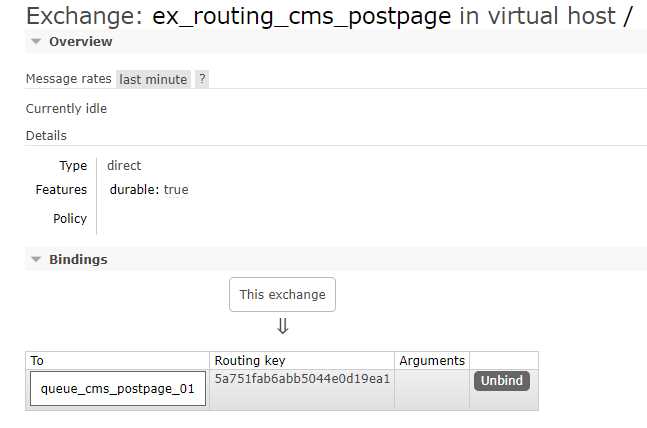
课程管理包括如下功能需求:
1、分类管理
2、新增课程
3、修改课程
4、预览课程
5、发布课程
用户的操作流程如下:
1、进入我的课程
2、点击“添加课程”,进入添加课程界面
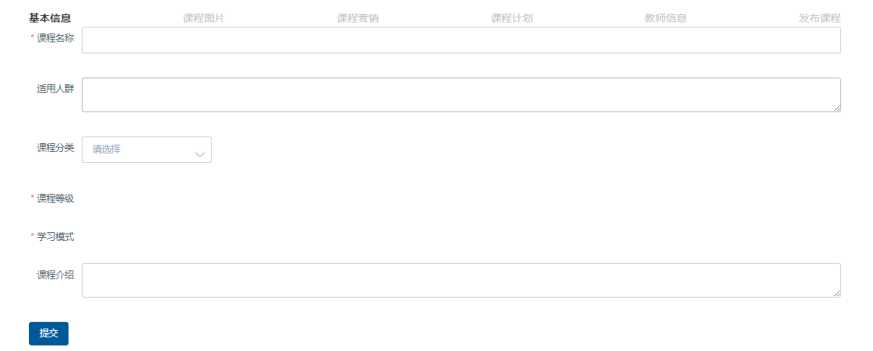
3、输入课程基本信息,点击提交
4、课程基本信息提交成功,自动进入“管理课程”界面,点击“管理课程”也可以进入“管理课程”界面
1) 创建数据库
课程管理使用MySQL数据库,创建课程管理数据库:xc_course。
导入xc_course.sql脚本

2) 数据表介绍
课程信息内容繁多,将课程信息分类保存在如下表中:
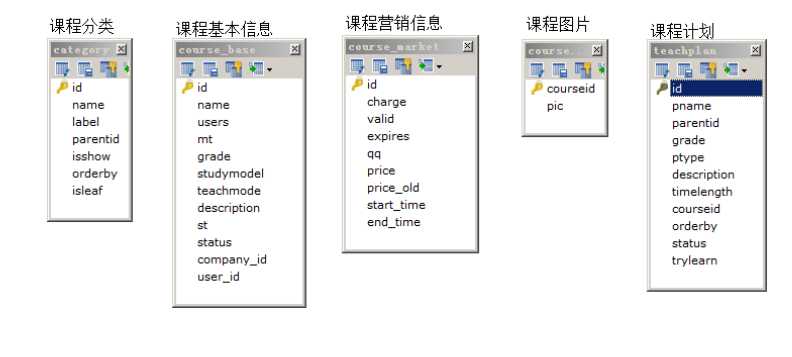
持久层技术介绍:
课程管理服务使用MySQL数据库存储课程信息,持久层技术如下:
1、spring data jpa:用于表的基本CRUD。
2、mybatis:用于复杂的查询操作。
3、druid:使用阿里巴巴提供的spring boot 整合druid包druid-spring-boot-starter管理连接池。
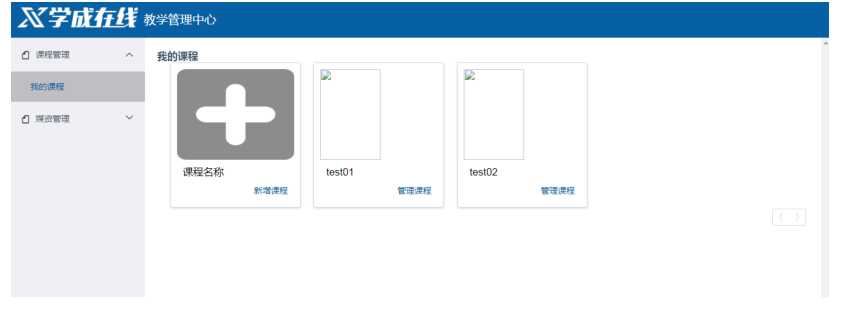

左侧显示的就是课程计划,课程计划是一个树型结构,方便扩展课程计划的级别。
在上边页面中,点击“添加课程计划”即可对课程计划进行添加操作。
点击修改可对某个章节内容进行修改。
点击删除可删除某个章节。
在course_plan.vue文件中添加tree组件的代码,进行测试:
1、组件标签
<el‐tree :data="data" show‐checkbox node‐key="id" default‐expand‐all :expand‐on‐click‐node="false" :render‐content="renderContent"> </el‐tree>
2、数据对象
let id = 1000; export default { data() { return { data : [{ id: 1, label: ‘一级 1‘, children: [{ id: 4, label: ‘二级 1‐1‘, children: [{ id: 9, label: ‘三级 1‐1‐1‘ }, { id: 10, label: ‘三级 1‐1‐2‘ }] }] }] } } }
课程计划是树型结构,采用表的自连接方式进行查询,sql语句如下:
SELECT a.id one_id, a.pname one_pname, b.id two_id, b.pname two_pname, c.id three_id, c.pname three_pname FROM teachplan a LEFT JOIN teachplan b ON a.id = b.parentid LEFT JOIN teachplan c ON b.id = c.parentid WHERE a.parentid=‘0‘ AND a.courseid=‘4028e581617f945f01617f9dabc40000‘ ORDER BY a.orderby, b.orderby, c.orderby
1) mapper接口
@Mapper public interface TeachplanMapper { public TeachplanNode selectList(String courseId); }
2)mapper映射文件

<resultMap type="com.xuecheng.framework.domain.course.ext.TeachplanNode" id="teachplanMap" > <id property="id" column="one_id"/> <result property="pname" column="one_name"/> <collection property="children" ofType="com.xuecheng.framework.domain.course.ext.TeachplanNode"> <id property="id" column="two_id"/> <result property="pname" column="two_name"/> <collection property="children" ofType="com.xuecheng.framework.domain.course.ext.TeachplanNode"> <id property="id" column="three_id"/> <result property="pname" column="three_name"/> </collection> </collection> </resultMap> <select id="selectList" resultMap="teachplanMap" parameterType="java.lang.String" > SELECT a.id one_id, a.pname one_name, b.id two_id, b.pname two_name, c.id three_id, c.pname three_name FROM teachplan a LEFT JOIN teachplan b ON a.id = b.parentid LEFT JOIN teachplan c ON b.id = c.parentid WHERE a.parentid = ‘0‘ <if test="_parameter!=null and _parameter!=‘‘"> and a.courseid=#{courseId} </if> ORDER BY a.orderby, b.orderby, c.orderby </select>
创建CourseService类,定义查询课程计划方法
@Service public class CourseService { @Autowired TeachplanMapper teachplanMapper; //查询课程计划 public TeachplanNode findTeachplanList(String courseId){ TeachplanNode teachplanNode = teachplanMapper.selectList(courseId); return teachplanNode; } }
@RestController @RequestMapping("/course") public class CourseController implements CourseControllerApi { @Autowired CourseService courseService; //查询课程计划 @Override @GetMapping("/teachplan/list/{courseId}") public TeachplanNode findTeachplanList(String courseId) { return courseService.findTeachplanList(courseId); } }
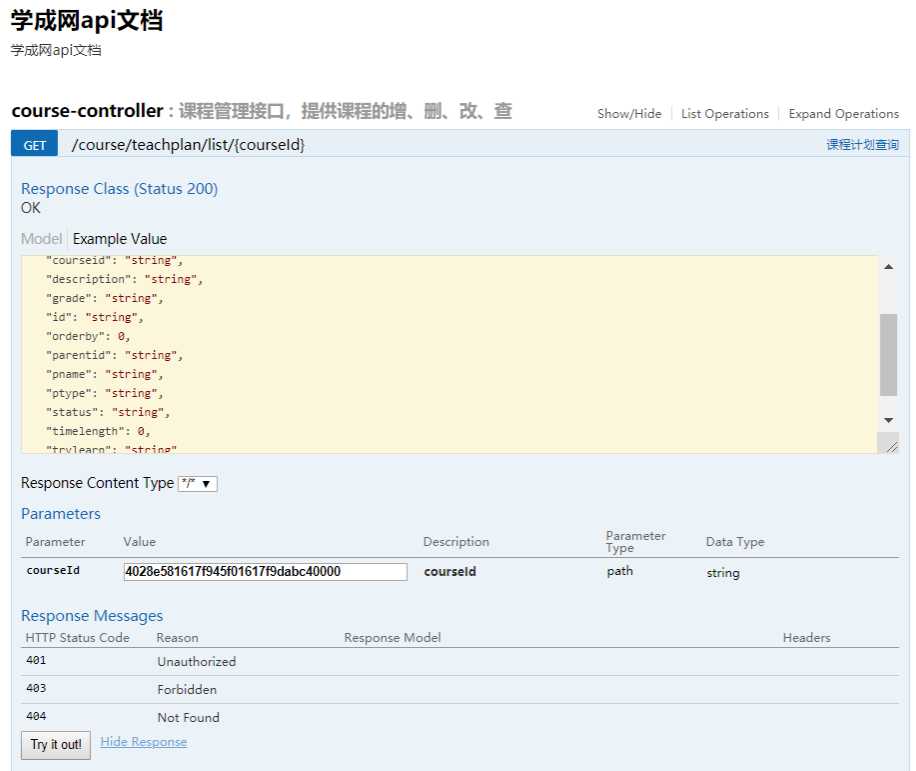
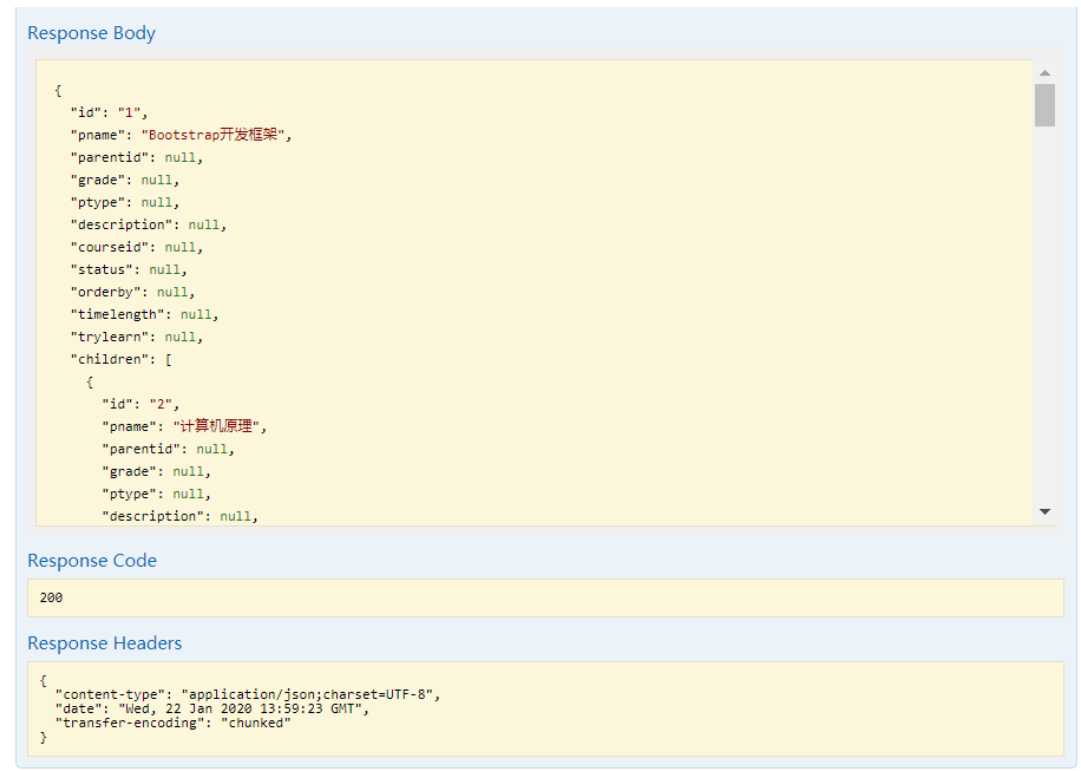


标签:结构 confirm 文件中 inf 发送消息 uri yml rate 生成
原文地址:https://www.cnblogs.com/anan-java/p/12231382.html